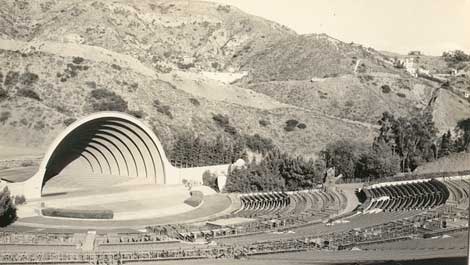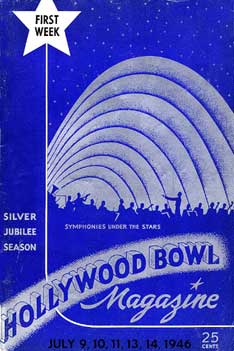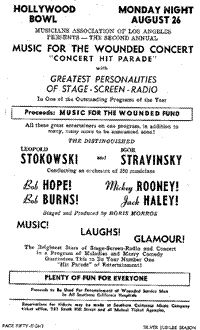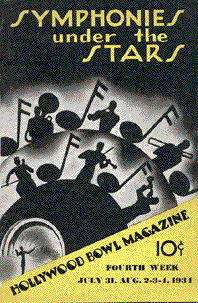Hollywood Bowl Lawsuit Appeal Filed

On August 3, Hollywood Heritage attorney Larry Teeter filed a notice of appeal for our lawsuit to protect the historic 1929 Hollywood Bowl orchestra shell from demolition by the County of Los Angeles. The announcement of the appeal caused the County toannounce it would delay its demolition, planned to have begun this October, for one year.
This delay, announced in the Los Angeles Times on June 7, was highlighted in several radio and television news broadcasts, including USA Today. Media coverage called it a “victory for preservationists” as County Supervisor Zev Yaroslavsky, the leader of the demolition proposal, revealed the delay to the Times. His stated reason was that the architect could not order the 482 tons of steel needed for the new shell on time.
 This
was confusing, as the architect, Craig Hodgetts, would not order the steel,
it would be done by the contractor, who was not identified. In addition, the
existing shell has only 86 tons of steel in it, so the new shell is not just
considerably larger, but considerably more rigid. This rigidity would contribute
to acoustic problems, especially as structural steel of today has more strength
with less weight than that of 1929.
This
was confusing, as the architect, Craig Hodgetts, would not order the steel,
it would be done by the contractor, who was not identified. In addition, the
existing shell has only 86 tons of steel in it, so the new shell is not just
considerably larger, but considerably more rigid. This rigidity would contribute
to acoustic problems, especially as structural steel of today has more strength
with less weight than that of 1929.
The Times did finally mention that the County’s contract with the Los Angeles Philharmonic at the Bowl ends in 2005. Yaroslavsky said “It’s been a classical music venue first and foremost, since the 1920s. It’s never been anything else and it shouldn’t be anything else” (emphasis added). “Shouldn’t” is hardly a reassuring word to use when insisting that Hollywood Heritage is wrong when it states that the Bowl would be turned over to large-scale pop and rock concerts, at a greater profit, when the Philharmonic’s contract ends and if a new, larger, shell is built.
Despite Yaroslavsky’s assurances that relationships with the Philharmonic are wonderful, he further stated, “there are many issues we have to negotiate with the Phil that will be contentious and difficult and involve a lot of give and take . . .” Why is this so as the Phil has been at the Bowl for almost 80 years? Hasn’t the County worked out the problems they may have with the Philharmonic during that period so that negotiations would not be “contentious and difficult”? Or are there other issues with the negotiations that are not being mentioned when the supervisor states, “I think the partnership is as sound today as ever.”?
 These
concerns were further hammered home when the County made an offer of settlement
to Hollywood Heritage after the initial announcements of our intention to
appeal in May. The County offered to pay Hollywood Heritage $40,000 to cover
legal costs and for work at Wattles Mansion and the Hollywood Heritage Museum.
It also offered to give us two seats on the Hollywood Bowl Community Advisory
Board, add our name to the mailing list for two years (subject to further
renewal) and extend the museum’s lease (which is on the County’s Bowl parking
lot / picnic area) for two years (our 20-year lease coincidentally expires
at the end of 2005). And of course, end the lawsuit.
These
concerns were further hammered home when the County made an offer of settlement
to Hollywood Heritage after the initial announcements of our intention to
appeal in May. The County offered to pay Hollywood Heritage $40,000 to cover
legal costs and for work at Wattles Mansion and the Hollywood Heritage Museum.
It also offered to give us two seats on the Hollywood Bowl Community Advisory
Board, add our name to the mailing list for two years (subject to further
renewal) and extend the museum’s lease (which is on the County’s Bowl parking
lot / picnic area) for two years (our 20-year lease coincidentally expires
at the end of 2005). And of course, end the lawsuit.
Hollywood Heritage’s response to these issues was as follows: We never filed this lawsuit to make financial profit from it. Accepting these funds as payment to demolish the shell and violate several important environmental laws that protect historic structures (thereby setting legal precedent) would be taking nothing less than blood money. Hollywood Heritage is not to be confused with others who put a price on preservation.
As for the Advisory Board, part of our lawsuit demonstrates how they were kept in the dark about the demolition plans and community notification. Our name, according to state law, was and still is to have been on the mailing list as a “concerned party” for such issues and as being “within the sphere of influence” of the Bowl. The County denied our claims in court that Hollywood Heritage had not been notified of the demolition process (along with most of the neighborhood). This offer to put us on the notification list is not just an admission of a violation of the law, but a lack of will to enforce the law, stating that we would only be notified if we signed the agreement and even then for only two years. The County’s actions continue to erode the community’s rights.
It should be noted that the other “concerned party” for such a project, the Los Angeles Conservancy, was notified, yet somehow didn’t think it was worth consulting with Hollywood Heritage about the destruction of one of our most famous landmarks.
The lease for the museum is a separate issue from the lawsuit and it should not be combined. Even if they were, why just 2 years for an extension? Why not another 20?
Hollywood Heritage offered the County and the Los Angeles Philharmonic a counter offer. In it we proposed that we be allowed to prepare and present an alternative plan for the shell’s improvements to include adding two new rings to the front of the shell. This would allow for accommodation of the orchestra under the shell. Other plans would improve acoustics for the orchestra and the audience, improve stage lighting and accessibility, and protect the historic shell and maintain the visual integrity of the site (avoiding the admitted negative impacts of adding seven 85-foot tall light and sound towers). This would also protect the surrounding residents from increases in noise and glare that would result from the larger shell proposed by the County.
 This
study would have been paid for by Hollywood Heritage and would be prepared
by several experts in the outdoor (and indoor) concert fields, all of whom
have extensive Hollywood Bowl experience. This would have provided authoritative
information and plans that would have created a facility that meets the requirements
of historic preservation laws and would provide a project superior to the
County version in acoustics, lighting, staging, and visual areas of concern,
and at a substantially reduced cost to build.
This
study would have been paid for by Hollywood Heritage and would be prepared
by several experts in the outdoor (and indoor) concert fields, all of whom
have extensive Hollywood Bowl experience. This would have provided authoritative
information and plans that would have created a facility that meets the requirements
of historic preservation laws and would provide a project superior to the
County version in acoustics, lighting, staging, and visual areas of concern,
and at a substantially reduced cost to build.
In addition, the County would agree to not issue a “negative declaration” for environmental review of any parking structure to be built on the parking lots east of Highland Avenue. Proposals exist to build at least a second level there adding 2,000 parking spaces. The impacts on the surrounding residential community, with its historic districts and houses, would include noise, air pollution, glare, traffic, and visual blight and need to be addressed in a full Environmental Impact Report. Of course, these additional spaces would not be need if the Bowl continues as a classical music venue as it is today.
We asked for the Environmental Review process for the shell’s demolition to be reopened and be properly prepared, including adequate notification to the impacted residential neighborhoods. This would cover a number of legal concerns, including the preparation of an alternative plan to protect and reuse the shell, as we proposed above. This would prevent any dangerous legal precedents resulting from this case to weaken laws protecting landmark structures.
Most telling though, was our demand that the Philharmonic contract be renewed, subject to minor modifications, for a period of at least an additional 20 years, as with past renewals. If indeed the new facility was being built for them, here was an opportunity to prove it. Since the County had brought up the Hollywood Heritage Museum lease, we felt that it would be far more appropriate to deal with the issue at hand, the Philharmonic lease.
The conditions were reviewed by the County and the Los Angeles Philharmonic. Both parties turned them down. In essence, the Philharmonic refused to extend their own lease on their most profitable operation, and Supervisor Yaroslovsky refused to put his vote where his mouth was. No counter offer to Hollywood Heritage was made, nor any explanation of their reasons for refusal.
Later, a high ranking Philharmonic official told Hollywood Heritage president Robert W. Nudelman the reason: Though they appreciated our offer to include the extension of their lease, they couldn’t accept it if it meant staying in the existing shell, even if it was improved as per Hollywood Heritage’s recommendations. When asked why they would forfeit the profits and prestige of playing there if all their stated requirements would be met in our plan (which was not questioned), the answer was aesthetics. The larger shell was now needed to make it look more like an earlier version in 1928. Not to improve acoustics for the orchestra, which was the sole reason in court to justify the demolition (“Statement of Overriding Consideration”).
It is hard to believe the Philharmonic can act this irresponsibly, both for financial and performance reasons. But it does demonstrate the County’s lack of good faith in its claims to keep the Philharmonic at the Bowl and not make changes with proper public input—changes that would greatly alter the nature of the Hollywood Bowl into a large pop and rock venue and severely impact the surrounding neighborhood. As the appeal proceeds, we will continue to publish pertinent documents on our web site: http://www. hollywoodheritage.org.